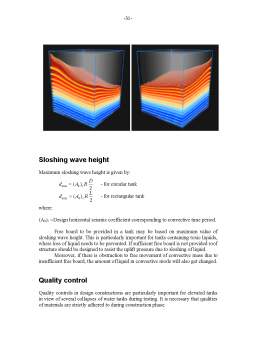Cuprins
- Chapter 1 Introduction
- Thesis Objectives.3
- Importance of subject.3
- Chapter 2 Thematic Chapters
- Spring Mass Model for Seismic Analysis.6
- Time Period.15
- Damping.21
- Design Horizontal Seismic Coefficient.21
- Base shear.24
- Base moment.24
- Direction of Seismic Force.25
- Hydrodynamic Pressure.25
- Pressure Due to Wall Inertia.29
- Effect of Vertical Ground Acceleration.30
- Sloshing wave height.31
- Quality control.31
- Chapter 3 Case study
- Design of a cylindrical RC water tank.32
- Microsoft PM - applied /customized to the subject.36
Extras din proiect
Thesis Objectives
This thesis provides the design procedure of cylindrical and rectangular ground-supported tanks. The procedure takes into account impulsive and convective(sloshing) actions of the liquid in concrete tank fixed to rigid foundation, seismic responses – base shear, overturning moment, and sloshing wave effect.
Importance of subject
Large-capacity ground supported tanks are used to store a variety of liquids – water for drinking and fire fightning, petroleum, chemicals, liquefied natural gas, etc. Satisfactory performance of tanks during strong ground shaking is crucial for modern facilities.
The seismic performance of storage tanks is a matter of special importance extended beyond the economic value of the tanks and contents. Without an assured water supply, uncontrolled fires subsequent to a major earthquake may cause substantially more damage than the earthquake itself, as occured in the great 1906 San Francisco earthquake. Safe supplies of drinking water are also essential immediatly following destructive earthquakes to avoid outbreaks of disease. Consequently, water supply reservoirs must remain functional after earthquakes. Failure of tanks containing highly inflamable petroleum products has lead to extensive uncontrolled fires, as occurred, for example, following the Niigata and Alaska earthquake of 1964. Spillage of toxic chemicals or liquified gases from damaged tanks could release dangerous liquids or gas clouds with disastrous effects in populous areas.
Different modes of tank failure have been observed after earthquakes:
• elastic-plastic buckling of the steel tank wall near the bottom edge ("elephant footing"), caused by axial compression forces due to the overturning moment.
• elastic buckling due to low pressure near the top.
• failure of the roof
• sloshing damage to upper shell of the tank
• failure of the bottom plate.
• failure of the foundation.
• fracture of piping at the connection to the tank.
• sliding of the tank
• failure of the support columns of reinforced concrete tanks
• Corrosion caused the roof of a spent sulfuric acid storage tank to have perforations that allowed sparks from a hot steel burning operation to enter the tank and ignite the flammable vapors present. The resulting explosion blew the tank off its foundation and released a large quantity of spent sulfuric acid onto the ground. The welder performing the cutting operation was killed. This failure could have been foreseen and prevented with modern techniques of inspection and monitoring.
• burned cylindrical tank
Spring Mass Model for Seismic Analysis
Provisions for Seismic Design
Hydrodynamic forces exerted by liquid on tank wall shall be considered in the analysis in addition to hydrostatic forces. These hydrodynamic forces are evaluated with the help of spring mass model of tanks.
Dynamic analysis of liquid containing tank is a complex problem involving fluid-structure interaction. Based on numerous analytical, numerical, and experimental studies, simple spring mass models of tank-liquid system have been developed to evaluate hydrodynamic forces.
When a tank containing liquid vibrates, the liquid exerts impulsive and convective hydrodynamic pressure on the tank wall and the tank base in addition to the hydrostatic pressure. In order to include the effect of hydrodynamic pressure in the analysis, tank can be idealized by an equivalent spring mass model, which includes the effect of tank wall – liquid interaction. The parameters of this model depend on geometry of the tank and its flexibility.
When a tank containing liquid with a free surface is subjected to horizontal earthquake ground motion, tank wall and liquid are subjected to horizontal acceleration. The liquid in the lower region of tank behaves like a mass that is rigidly connected to tank wall. This mass is termed as impulsive liquid mass which accelerates along with the wall and induces impulsive hydrodynamic pressure on tank wall and similarly on base. Liquid mass in the upper region of tank undergoes sloshing motion. This mass is termed as convective liquid mass and it exerts convective hydrodynamic pressure on tank wall and base. Thus, total liquid mass gets divided into two parts, i.e., impulsive mass and convective mass. In spring mass model of tank-liquid system, these two liquid masses are to be suitably represented. Sometimes, vertical columns and shaft are present inside the tank. These elements cause obstruction to sloshing motion of liquid. In the presence of such obstructions, impulsive and convective pressure distributions are likely to change. At present, no study is available to quantify effect of such obstructions on impulsive and convective pressures. However, it is reasonable to expect that due to presence of such obstructions, impulsive pressure will increase and connective pressure will decrease.
Preview document
Conținut arhivă zip
- Seismic Analysis of Ground Supported Concrete Water Tanks.doc









































